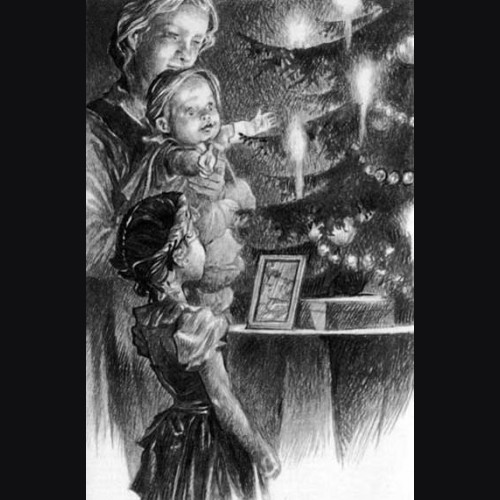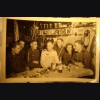Weihnachten (Christmas) and Symbolism # 846
Each year as the holidays approach people
around the world gather among family and friends to celebrate Christmas
and the birth of Christ. While religion is not one of my strong points,
growing up in a household that not only celebrated Christmas but a
Norwegian heritage made for some interesting traditions.
These
traditions carried out by many family's during the holidays can vary
and serve to celebrate not only the Christmas holiday but the heritage
and ancestry of any given family and their people. Carried down
centuries from father to son and mother to daughter, traditions serve to
remind us of not just where we come from but what we are.
As people run to the malls and gather their gifts and garnish their trees in anticipation of the coming holiday I can not help but notice while scanning various websites and forums in some cases a total lack of understanding pertaining to the symbolic significance of historical artifacts and their actual roots and connection to Christmas.
When
I initially put this site up geared to the Third Reich it was not
intended to be anything but a celebration of culture, while the era
itself is dark and the items to outsiders may seem odd, the Reich in its
short time in existence exploded with some of the finest artistic works
ever produced and bought forth some of the most interesting items
relating to culture and the ancestry of the German and European people
and their Pre- Christian roots.
Most all of the symbols
incorporated into the Christian religion and the celebration of
Christmas predate the Christian religion and the birth of Christ and are
attributed to ancient European beliefs and their worship to various
Gods. These symbols were utilized by the National Socialist regime to
take the German people back to their roots as people of family and of
the earth.
"With the
notable exception of the Nativity scene, nearly all the symbols and
decorations that we associate with Christmas such as the tree, wreath,
holly and Ivy, lights, mistletoe, eggnog, yule log, Christmas caroling,
and even Santa Claus are of Pagan origin. Many Americans, in fact, often
refer to Christmas as "the Yuletide" And no wonder: Yule is the winter
solstice. Most modern Pagans still celebrate Yule. Even most Christians
use Christmas and Yule interchangeably to describe the season without
thinking of its Pagan origin."
The Pagans celebrated
Yule, symbolic of the pagan sun god Mithris and his birth and celebrated
on the shortest day of the year. As the sun god grew and matured the
days became longer and warmer. It was customary to light a candle to
encourage Mithras, and the sun, to reappear next year.
Huge Yule logs were burned in honor of the sun. The word Yule itself means “wheel,†the wheel being a pagan symbol for the sun. Mistletoe was considered a sacred plant, and the custom of kissing under the mistletoe began as a fertility ritual. Holly berries were thought to be a food of the gods.
The tree is the one symbol that unites almost all the northern
European winter solstices. Live evergreen trees were often brought into
homes during the harsh winters as a reminder to inhabitants that soon
their crops would grow again. Evergreen bows were sometimes carried
as totems of good luck and were often present at weddings, representing
fertility. The Druids used the tree as a religious symbol, holding
their sacred ceremonies while surrounding and worshipping huge trees.
It was not until approximately 312 with Emperor Constantine that
Christianity rose to be the dominant religion in the Roman Empire, It is
here that these pagan symbols are adopted into the Christian religion.
While
many think that Christianity was stifled during the Reich, it does not
really appear to be the case. Heinrich Himmler did take his SS men to a
level of Pagan ritual and living, even issuing a guide on how the
holidays should be celebrated within an SS family, the National
Socialist Party utilized many of the symbols as well and incorporated
them in many ways, but the civilian populace and various branches of
service clearly show that Weihnachten (Christmas) was in fact alive and
well. The reason for this by most accounts is that the strength of the
Christian religion and the inability of the N.S Party to overcome it.
In
one notable example of the foothold of Christianity, SS
Obergruppenfuhrer Oswald Pohl, head of the SS economic concerns and the
camp systems under Himmler referenced the following poem from the The
Consecration of the Night by Hebbel to adorn a commercially sold
Juhlfest plate and signed with his signature.
From all the stars, flows a glorious blessing,
So that tired strength can
once more feel itself refreshing,
Out of darkness moves the Lord, as far as
he can,
And the threads which have been broken he is mending all again.
I remember one family Christmas where everyone was so eager to open presents that we managed to catch the ire of my father who felt we were missing the point, we were, and while that made for a couple tense hours we eventually over came it by feeding him some Glugg or Glogg, a home made wine that had been made within the family every year for as long as I can remember.
While the ire of my father on that one Christmas was no doubt bought on by a failure to acknowledge the birth of Christ, I also have no doubt that he understood the roots of Christmas and its symbolism. I am my fathers son.
Merry Christmas and Yuletide Greetings!!
Weihnachten (Christmas) and Symbolism
Each year as the holidays approach people
around the world gather among family and friends to celebrate Christmas
and the birth of Christ. While religion is not one of my strong points,
growing up in a household that not only celebrated Christmas but a
Norwegian heritage made for some interesting traditions.
These
traditions carried out by many family's during the holidays can vary
and serve to celebrate not only the Christmas holiday but the heritage
and ancestry of any given family and their people. Carried down
centuries from father to son and mother to daughter, traditions serve to
remind us of not just where we come from but what we are.
As people run to the malls and gather their gifts and garnish their trees in anticipation of the coming holiday I can not help but notice while scanning various websites and forums in some cases a total lack of understanding pertaining to the symbolic significance of historical artifacts and their actual roots and connection to Christmas.
When
I initially put this site up geared to the Third Reich it was not
intended to be anything but a celebration of culture, while the era
itself is dark and the items to outsiders may seem odd, the Reich in its
short time in existence exploded with some of the finest artistic works
ever produced and bought forth some of the most interesting items
relating to culture and the ancestry of the German and European people
and their Pre- Christian roots.
Most all of the symbols
incorporated into the Christian religion and the celebration of
Christmas predate the Christian religion and the birth of Christ and are
attributed to ancient European beliefs and their worship to various
Gods. These symbols were utilized by the National Socialist regime to
take the German people back to their roots as people of family and of
the earth.
"With the
notable exception of the Nativity scene, nearly all the symbols and
decorations that we associate with Christmas such as the tree, wreath,
holly and Ivy, lights, mistletoe, eggnog, yule log, Christmas caroling,
and even Santa Claus are of Pagan origin. Many Americans, in fact, often
refer to Christmas as "the Yuletide" And no wonder: Yule is the winter
solstice. Most modern Pagans still celebrate Yule. Even most Christians
use Christmas and Yule interchangeably to describe the season without
thinking of its Pagan origin."
The Pagans celebrated
Yule, symbolic of the pagan sun god Mithris and his birth and celebrated
on the shortest day of the year. As the sun god grew and matured the
days became longer and warmer. It was customary to light a candle to
encourage Mithras, and the sun, to reappear next year.
Huge Yule logs were burned in honor of the sun. The word Yule itself means “wheel,†the wheel being a pagan symbol for the sun. Mistletoe was considered a sacred plant, and the custom of kissing under the mistletoe began as a fertility ritual. Holly berries were thought to be a food of the gods.
The tree is the one symbol that unites almost all the northern
European winter solstices. Live evergreen trees were often brought into
homes during the harsh winters as a reminder to inhabitants that soon
their crops would grow again. Evergreen bows were sometimes carried
as totems of good luck and were often present at weddings, representing
fertility. The Druids used the tree as a religious symbol, holding
their sacred ceremonies while surrounding and worshipping huge trees.
It was not until approximately 312 with Emperor Constantine that
Christianity rose to be the dominant religion in the Roman Empire, It is
here that these pagan symbols are adopted into the Christian religion.
While
many think that Christianity was stifled during the Reich, it does not
really appear to be the case. Heinrich Himmler did take his SS men to a
level of Pagan ritual and living, even issuing a guide on how the
holidays should be celebrated within an SS family, the National
Socialist Party utilized many of the symbols as well and incorporated
them in many ways, but the civilian populace and various branches of
service clearly show that Weihnachten (Christmas) was in fact alive and
well. The reason for this by most accounts is that the strength of the
Christian religion and the inability of the N.S Party to overcome it.
In
one notable example of the foothold of Christianity, SS
Obergruppenfuhrer Oswald Pohl, head of the SS economic concerns and the
camp systems under Himmler referenced the following poem from the The
Consecration of the Night by Hebbel to adorn a commercially sold
Juhlfest plate and signed with his signature.
From all the stars, flows a glorious blessing,
So that tired strength can
once more feel itself refreshing,
Out of darkness moves the Lord, as far as
he can,
And the threads which have been broken he is mending all again.
I remember one family Christmas where everyone was so eager to open presents that we managed to catch the ire of my father who felt we were missing the point, we were, and while that made for a couple tense hours we eventually over came it by feeding him some Glugg or Glogg, a home made wine that had been made within the family every year for as long as I can remember.
While the ire of my father on that one Christmas was no doubt bought on by a failure to acknowledge the birth of Christ, I also have no doubt that he understood the roots of Christmas and its symbolism. I am my fathers son.
Merry Christmas and Yuletide Greetings!!
Weihnachten (Christmas) and Symbolism



-100x100.jpg)
-100x100.jpg)
-100x100.jpg)
-100x100.jpg)
-100x100.jpg)
-100x100.jpg)
-100x100.jpg)
-100x100.jpg)
-100x100.jpg)
-100x100.jpg)
-100x100.jpg)
-100x100.jpg)
-100x100.jpg)
-100x100.jpg)
-100x100.jpg)
-100x100.jpg)
-100x100.jpg)
-100x100.jpg)
-100x100.jpg)
-100x100.jpg)
-100x100.jpg)
-100x100.jpg)
-100x100.jpg)
-100x100.jpg)
-100x100.jpg)
-100x100.jpg)
-100x100.jpg)
-100x100.jpg)
